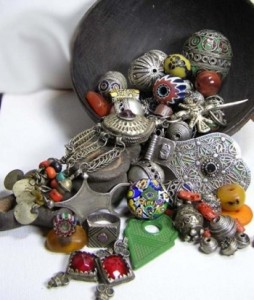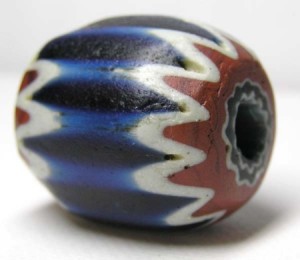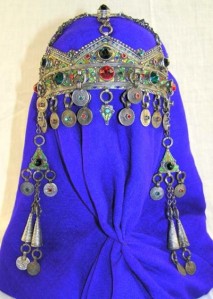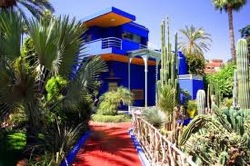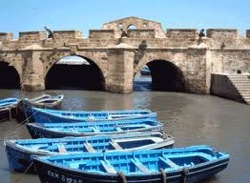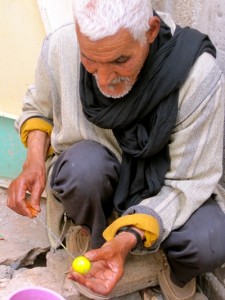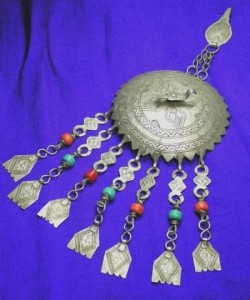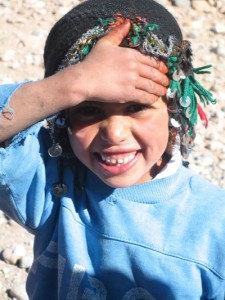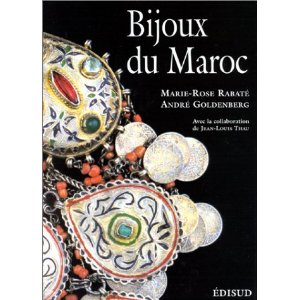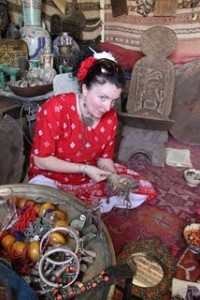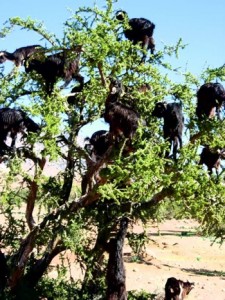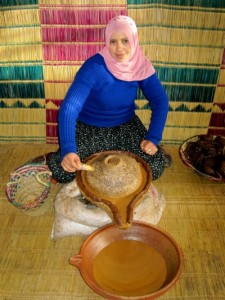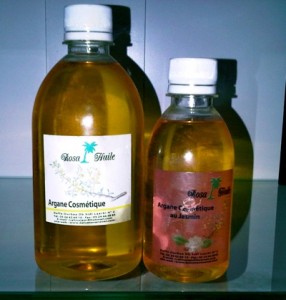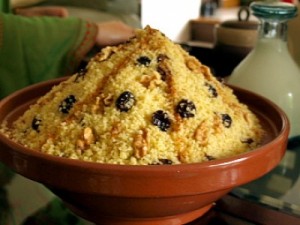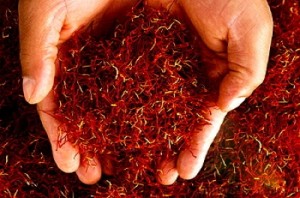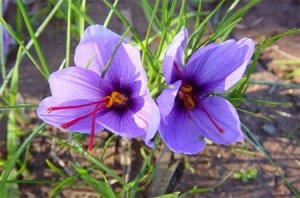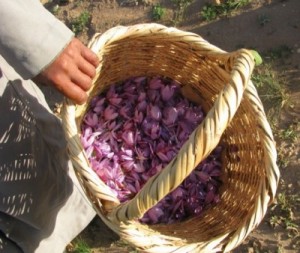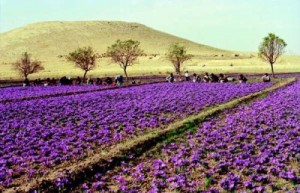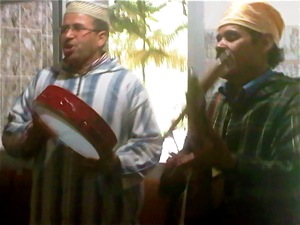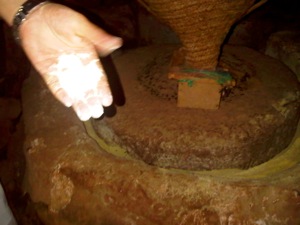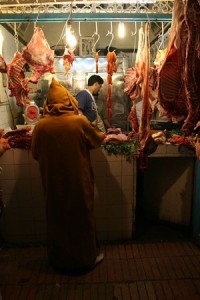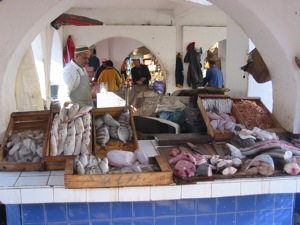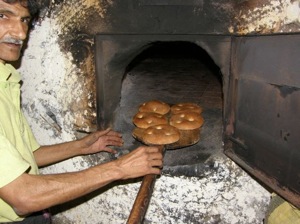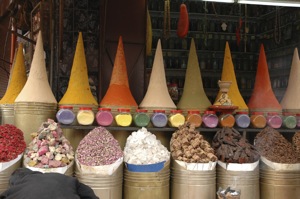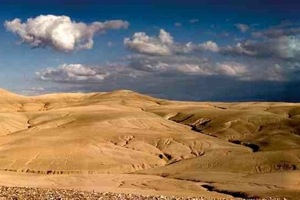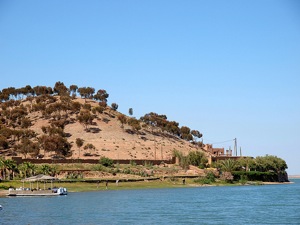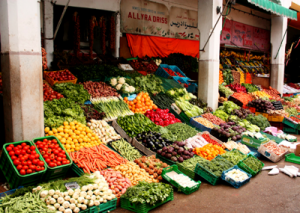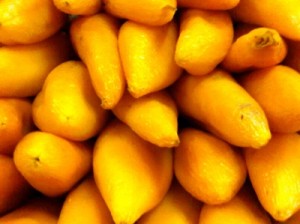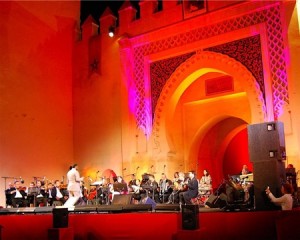
Celebration is an important aspect of Moroccan culture. Morocco is an exciting and entertaining country that lays claim to cultural, historical and religious holidays and festivals. At any given point of the year there is a Moroccan city or Berber community hosting glorious festivities. Moroccan celebrations can last anywhere from a few days up to two weeks. The exception is Ramadan which lasts for thirty days. While Moroccans celebrate numerous Muslim and national festivals through the year, the dates for most of their religious festivals are based upon the lunar calendar. Therefore it is difficult to predict when religious holidays will fall within the western calendar utilized by most people in the world.
During Moroccan festivities, one can expect to encounter fasting, dancing and feasting – all depending on the type of holiday being celebrated. The Muslim festivals and religious holidays are traditionally observed by all Moroccans regardless of how long they last. They are also often observed by foreigners living in Morocco.
Some famous festivals are: the Almond Blossom Festival which marks the time when these trees bare their leaves in splendid shades of pinks and whites; the Festival of Roses in El Kelaa M’Gouna which gives way to thousands of blooming roses whose scents lingers all during the festival whereby the annual Ms. Roses is chosen; the Fes Festival of Sacred World Music, the Gnaoua Festival, the Timitar Festival of Agadir celebrating Amazigh (Berber) music and the Sufi Festival. Morocco’s leading festival that commands top attendance is The International Film Festival of Marrakech; for its attraction of film makers from around the world who flock to show their feature films and shorts.
Every festival is an adventure and offers an opportunity to connect with locals to experience Moroccan culture. Moroccan festivals and celebrations are fascinating and immensely enjoyable therefore visiting during one of them can greatly enhance your trip to the country.
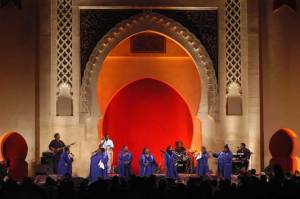
Fes Festival of Sacred World Music, Fes
FES FESTIVAL OF WORLD SACRED MUSIC – This Festival takes place in June each year
A 10-day sacred music festival celebrating spiritual traditions from around the world.
he Fes Festival of World Sacred Music in Morocco is 10-day celebration held in mid-summer (late May or early June) that takes place in the imperial city of Fes. The festival was founded in 1994 by the Moroccan scholar and philanthropist Faouzi Skaliand was created to showcase major musical traditions of sacred, spiritual music and world music. The current Artistic Director is Cherif Khaznadar, a pioneer of world music and one of the most influential Artistic Directors on the scene. Each year the festival celebrates artists from Muslim, Jewish, Christian, Hindu and other faiths to perform together in a spirit of mutual respect and collaboration.
The Fes Festival is comprised of:
A four-day Forum called Rencontres de Fes under the rubric “Giving Soul to Globalisation” where politicians, social activists, academics and religious leaders come together in dialogue to discuss the urgent issues of our times. These include conflict resolution, climate change, urban renewal, social justice and much more.
Intimate afternoon concerts at the Dar Batha Museum and its surrounding Andalusian gardens.
Art and film exhibitions, poetry readings at the Dar Bartha Museum and other locations within Fes.
A one-day excursion to the Roman ruins of Volubilis with Arc of Triumph as a backdrop setting for a musical performance.
Evening concerts at the Bab Makina Palace courtyard.
Sufi nights: Sufi music rituals concerts that begin at midnight performed by Moroccan Sufi brotherhoods in the Dar Tazi gardens, in the heart of the Fes medina.
The Festival has featured wide range of global musicians such as Miriam Makeba,Ismael Lô, Mohamed Abdou, Tartit Women’s Ensemble, Ghada Shbéïr, , Sabah Fakrih, the Blind Boys of Alabama, Jan Garbarek and The Hilliard Ensemble and the Whirling Dervishes of Konya in the dance of Odissi Madhvi Mudgal. Performers likeYoussou N’Dour, Ravi Shakar and Salif Keita have been juxtaposed with less known musical genres such as Japanese Gagaku, Indonesian Gamelan and folk music fromCentral Asia.
The Fes Festival is unique because it has roots in spiritual values and encourages the audience to become active participants. The festival’s president, Mohamed Kabbaj, wants the festival to act as an anchoring ground to teach people to learn to appreciate different cultures and to communicate better with one another.
In addition to bringing attention to various cultures, the Fes Festival has been a wonderful tool specifically in raising awareness for Moroccan culture. During the day, tourists arriving to enjoy the Fes Festival explore Fes’ medina, souk, mosques and other city highlights. At night, they delight in the musical festivities.
The festival is not just confined to one square in Fes. In honor of the festival there are art exhibitions and concerts held at the Dar Batha museum, talks at Palace Jamai, free concerts in the medina and in the new city, as well as many children’s activities, making it a great family destination.
In the morning, visitors can take part in seminars or round table discussions covering topics related to the theme of the festival. By attending the discussion, you can gain extra insight into the meaning of the festival.
In the afternoon, evening, and late at night, there are concerts given by performers arriving from every angle of the globe. These musicians help celebrate all the cultures and religions of the world through a multiplicity of their songs and rituals. The musical spectrum heard includes early European classical, Sufi ritual songs and trance music, Arab-Andalusian rhythms, a Bulgarian orthodox choir, Hindustani chants, Celtic sacred music, Christian Gospel, Swedish chamber choir, Pakistani Qawwali incantations, Egyptian madhi odes, flamenco-style Christian saeta, ancient Indian gwalior chants and Turkish whirling dervishes.
Traditionally, the festival’s most impressive afternoon concerts take place by theDarBathaMuseum, which is set amidst a beautiful Andalusian garden and has a backdrop of the Atlas Mountains. During the evening concerts are held at the Bab Makina and Palace Boujeloud. After the last concert of the night is over, the medina is the place to head for a continuation of a once in a life time experience. Every evening at midnight, there are free “Sufi Nights”. These highly popular Sufi ritual trance performances are held at the DarTaziPalace gardens where Sufi brotherhoods like the Hamadcha, the Aissaoua and The Master Musicians of Jajouka perform while you relax on Berber rugs and sip mint tea.
If you want to place the Fes Festival on your itinerary, make sure to reserve accommodations in advance as the city fills up quickly with tourists for this spectacular annual event. The most sought after location to stay in is the medina because it is central to all the concerts and main activities.
The Fes Festival is a unique experience that combines high art, popular entertainment, spiritual energy and intellectual challenges. It resonates with the essence of our times and is rooted in The Spirit of Fes – ______________________________________________________________________________________________________________________________

Gnaoua Festival Musicians, Essaouira
GNAOUA MUSIC FESTIVAL – This Festival takes place in June each year
A famous 4-day extravaganza featuring art exhibitions and Gnaoua style, world and jazz music.
The mysterious music of the Gnaouas is celebrated each year in June at the Gnaoua Festival in Essaouira. Essaouira is an Atlantic seaside resort town and has long been considered as one of the best anchorages of the Moroccan coast. The medina of Essaouira (formerly “Mogador”) is a UNESCO World Heritage listed city, as an example of a late 18th century fortified town.
The Gnaoua Festival attracts a cosmopolitan audience of 500,000 festival-goers annually and offers a rich program, reaffirming its goal to emphasize the Gnaoua heritage in all its variety and to invite the best world and jazz artists to come and perform in the unique and magical town of Essaouira. This popular four day festival features art exhibitions and Gnaoua style music. International musicians and groups from Tangier, Marrakesh, and Essaouira perform their Gnaoua sounds at the Place Moulay Hassan and other spaces in the medina and outside its city walls such as Bab Doukkala, Bab Marrakech, Dar Souiri, Chez Kebin, Zaouia Gnaoua, Place Khayma and the Marche Aux Grain.
The festival recently honored the Gnaoua musicians with a new stage, which is dedicated to them at Bab Doukkala, allowing the ardent supporters of the Gnaoua rhythms to meet with the stars, from Hamid El Kasri to Abdelkébir Merchane. This stage was created for 100 % Gnaoua concerts, as well as the traditional lilas in the exceptional Gnaoua Zaouia (trance performances) every evening at midnight for the purists.
World and jazz musicians perform on the new stage Bab Sebaa and The Moulay Hassan stage is kept for the famous groups of very diverse styles. On the smaller stages in the medina, the new generation of maâlems performs, and fans of electronic fusion and contemporary Moroccan music now have two new dedicated areas: the Pepsi stage and the Méditel stage.
The Gnaoua Festival offers 10 concert sites from which everyone can choose according to their taste, 10 different but complementary programs forming the details of a unique puzzle, that of a pioneering and cosmopolitan festival. The quality is excellent as ever.
Each evening is usually broken down into a few parts. In the first part, the Gnaoua musicians perform between six and nine pm. After this portion ends, the audience will hear the sounds of the other non-Gnaoua jazz musicians.
The favorite of many is when Maâlem (Master) Gnaoua and their bands begin to play, around the eleven pm. The Maâlems have venerable stringed-instrument traditions involving both bowed lutes like the gogo and plucked lutes like the gimbri, also called hajhuj a three-stringed bass instrument.
The hajhouj, a guitar like instrument made of camel’s leather. Its strings come from the roots of trees combined with dried, twisted sheep or goat colons. The hajhouj gives Gnaoua music its distinctive bass sounds. Gnaoua hajhuj players use a technique which 19th century American minstrel banjo instruction manuals identify as “brushless drop-thumb frailing”. The “brushless” part means the fingers do not brush several strings at once to make chords. Instead, the thumb drops repeatedly in a hypnotically rhythmic pattern against the freely-vibrating bass string producing a throbbing drone, while the first two or three fingers of the same (right) hand pick out, often percussive patterns in a drum-like, almost telegraphic manner. The Gnawa hajhuj has strong historical and musical links to West African lutes like the Hausa halam, a direct ancestor of the banjo. The Gnawa also use large drums called the ganga or tbeland krakebs large iron castanets in their ritual music.
At the festival, the Maâlems begin to chant in Arabic or Gnaoui. The message is usually something spiritual or religious that has the power to heal. At one point in the songs, an instrument making “krakeb” sounds places the audience into a trance as both musicians and the audience begin to sway.
After the Maâlem, between 12am and 2am in the morning, there is a fusion of sounds between the spiritual Gnaoua music and the multi-cultural sounds of non-Gnaoua jazz musicians playing European, American, Rock, and African Blues. The late morning concerts are a fusion between these artists.
Great musicians who have performed at The Gnaoua Festival since its first edition in 1988 are: Trio Joubran with bluesman Justin Adams, Toumani Diabaté, Eric Legnini, KyMani Marley, Wayne Shorter, the National Orchestra of Barbès, Hassan Hakmoun, Will Calhonn, Adam Rudolf, Sussan Deyhim, Steve Shehan, Yéyé Kanté, Adam Rudolph, Mokhtar Samba, Yaya Ouattara, Jamey Haddad, Jacques Schwarz-Bart, Randy Weston, Adam Rudolph, The Wailers, Pharoah Sanders, Keziah Jones, Omar Sosa, Doudou N’Diaye Rose, the Italiam trumpet player Paolo Fresu and Ramon Valle.
The new generations of Gnaoua maâlems who have performed at the Gnaoua Festival are: Saïd Boulhimas, Midnight Shems, Darga, and Rif Gnawa. The established maâlems who have performed are: Allal Soudani, Saïd El Bourqui and Abdeslam Belghiti, Maâlem Abdallah El Gourd de Tanger. Maâlem Abdeslam Alikane et Tyour D’EssaouiraMaâlem Amida Boussou de Casablanca, Maâlem Brahim Balkani de Marakech, Maâlem Mahmoud Guinea d’Essaouira. Maâlem Abdelhatif Al Makhzoumi, Maâlem Allal Goubani, Maâlem Cherif Regragui, Maâlem Hayate, Saïd Boukri , Al Belghiti, Maâlem Abdallah El Gourd de Tanger, Maâlem Abdeslam Alikane et Tyour D’Essaouira, Maâlem Amida Boussou de Casablanca, Maâlem Brahim Balkani de Marakech, Maâlem Mahmoud Guinea d’Essaouira, Maâlem Abdelhatif Al Makhzoumi, Maâlem Allal Goubani, Maâlem Cherif Regragui, Maâlem Hayate, Saïd Boukri and Al Belghiti.
Gnaoua music is a mixture of African, Berber and Arabic religious songs and rhythms. It combines music and acrobatic dancing. Gnaoua music is both a prayer and a celebration of life. Though many of the influences that formed this music can be traced to sub-Saharan Africa, and specifically, the Western Sahel, its practice is concentrated in North Africa, mainly Morocco and Algeria
The Gnaouas are descendants from the black brotherhoods of slaves that were taken from Mali, Guinea, and Ghana to be transported by traders along the Caravan Route. Originally, their purpose was to serve as guards to Morocco’s sultans, however, the story states that when Bilal cured Mohammed’s daughter Fatima by singing her a song, their role gradually changed from guards to that of ‘musical doctors’ or those who heal the soul. The Gnaoua combine elements of African tradition with Islamic folklore during their nighttime trance rituals called lilas. Lilas generally last throughout the night and are filled with dancing, chants, and other ceremonies to encourage spirits inhabiting a human body to connect with and cure the soul.
In a Gnaoua song, similar to American pop music, one phrase or a few lines are repeated consistently regardless of how short or long the song may be; although most are quite long surpassing twenty minutes. In fact, a song may last up to several hours non-stop. To many who are unfamiliar with the Gnaoua, their performances may appear to be one long song when actually they are a series of spiritual chants. The chants sung by the Gnaoua describe the various spirits so what seems to be a 20 minute piece may be a whole series of pieces, a suite for Sidi Moussa, Sidi Hamou, Sidi Mimoun or the others. However because the songs are suited for invoking a state of trance, they go on and on.
Almost all Moroccan brotherhoods, such as the Issawa or the Hamadsha, relate their spiritual authority to a saint. The ceremonies begin by reciting that saint’s written works or spiritual prescriptions in Arabic. In this way, they assert their role as the spiritual descendants of the founder, giving themselves the authority to perform the ritual. Gnaoua, whose ancestors were neither literate nor native speakers of Arabic, begin the Lila by bringing back, through song and dance their origins, the experiences of their slave ancestors, and ultimately redemption.
The Gnaoua Festival of Essaouira has changed the face of the original Gnaoua ritual music by fusing its core spiritual music with similar genres like jazz, blues, reggae and hip-hop. The famous musicians that participate each year exchange and mix their own music with Gnaoua music, creating one of the largest public festivals in Morocco as well as one of the best and most exciting jam sessions.
______________________________________________________________________________________________________________________________
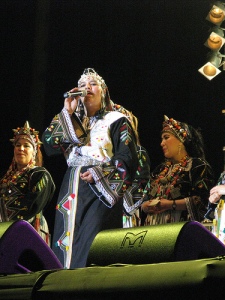
Timitar Festival, Agadir
TIMITAR MUSIC FESTIVAL IN AGADIR – This Festival takes place in July each year
The leading celebration of Amazigh culture and world music in the Souss Massa Drâa.
Featuring over 40 artists and 500,000 in attendance, Timitar Festival in Agadir, Morocco, has established itself as one the premiere African music festivals. Considered today as one of the biggest festivals in the country, Timitar provides its audience with an event well rooted in and actively working towards promoting Souss Massa Drâa culture.
The district council of Agadir Under Massa Draâ initiated the Timitar Festival with the goal to set up a cultural project for the meeting between Amazigh artists and world musicians. The President of the festival is the agricultural tycoon Aziz Akhennouch. The Artistic Director of the festival is Brahim El Mazned.
What defines Timitar from other music festivals in Morocco is its special focus on Amazigh culture. Its permanent theme is “signs and cultures” and Timitar lives up to this tag by including performances by traditional and modern Moroccan musicians alongside those of contemporary international artists.
Each year the Festival Timitar honors artists coming from all over the world including Africa, South America, Europe and the Middle East in order to offer the Agadir audience the best of numerous works in Amazigh traditional music, modern music from the Maghreb and elsewhere, rap, jazz and hip hop.
Since its creation, Timitar has become a key meeting point, both on artistic and cultural levels. As part of Timitar, the Timitar OFF program, which consists of a colloquium and workshops on Deejaying and Veejaying practices for young people, emphasizes Amazigh culture and world music.
The majority of Berbers, also referred to as Amazigh, went unrecognized in North Africa until the mid-‘90’s when they pressed the King publicly for their cultural traditions to be respected and honored. During recent years, the Amazigh have seen a cultural renaissance through recognition of their language in schools, increased awareness in tourism to the Southern region as well as a larger respect from Arab Moroccans and foreigners with regards to their cuisine, Kilim making and silver traditions. This cultural renaissance has been encouraged and fully supported by King Mohammed VI and was initiated by his father King Hassan.
Tashelhit is language of the majority of Berbers and is now being taught in a majority of schools in the South. The government says the aim is to have Berber classes taught in all schools and at all levels within the next 10 years. The move is a sign of increasing recognition of Moroccan Berbers, who have long complained of being denied their rights despite constituting the majority of the population. It is the first step in the fulfillment of a promise made nearly 10 years ago by the late King Hassan to bring Berber into the classroom.Although it is estimated that at least 60% of Moroccans are ethnically Berber or Amazigh as they are known in their own language, Morocco’s constitution enshrines Arabic as the country’s only official language.
Timitar Festival has produced 46 concerts since its inception. Staged in three open-air venues throughout Agadir, music can be enjoyed at the central Place al Amar, Place Bijaouane and the Théâtre de Verdure. The event is marked by the participation of foreign and domestic artists, presenting eclectic musical styles (Jazz, Hip-Hop, Indian, Spanish and Cuban music) as well as Moroccan culture, including Berber, Gnaoua and other internationally known styles. This great cultural event is organized with the objective of spiritual hospitality and the exchange and is organized around the concept of the meeting of Amazigh music with the music styles of the world.
World renowned artists that have performed at Timitar Festival are Youssou N’Door, Marcel Khalifa, Alpha Blondy, Cheb Khaled, Rokia Traoré, Najat Âatabou, Lamchaheb, Idir, Salif Keita, and Oulad el Bouazzaoui.
Berber groups who have graced the stage are Fatima Tabaamrant, Outajajt, Lahoucine Amarakchi, My Ahmed Ihihi, Fatima Tihihit and Haj Amentag. The audience also has the opportunity to discover new groups working with traditional music within the Souss Massa Drâa Region; who in the past have included Imghrane, Oudaden, Tarragt, Azenkd, Toudart, Lahoucine Aït Baamrane and Aït Laati.
Urban and contemporary music is also commemorated at this seafront festival in account of the alternative artists who made a mark on the local Moroccan music scene, such as Amarg Fusion, Darga, Fez City Clan and Rap 2 Bleb. International urban and contemporary hip hop groups such as Didier Awadi and his band Presidents of Africa and electronic music groups such as Zong and Nortec Collective have also made there way into the festival.
Timitar promises each year to include sounds and images with deejay and veejay sets. In 2008 the festival showcased Al Amal and Bijawane stages, featuring VJ Dennis Dezenn, Kiss Duband Rays; with Dj Big Buddha, Ishtar, Dj B*indi, Mps Pilot, Badr Eddine, Mixape, Dj Key and Dj Saïf.
The diverse line up of the Timitar festival holds strong to spirit of plurality inherent in world music and the Amazigh musical tradition. Attended by Moroccans and foreigners, the Timitar Festival is an exciting foray into Morocco in summer. Along with the spectacular music, one is guaranteed fresh seafood and cool air during the hottest season of the year.
______________________________________________________________________________________________________________________________

Berber-Imilchil-Marriage-Festival
IMILCHIL MARRIAGE FESTIVAL – This Festival takes place September each year
A legendary festival that is an homage to love and celebration of Berber Tradition.
The
Imilchil is located high up in the lake plateau of the Middle Atlas Mountains in Morocco. In this quaint village you will find primarily Berber tribal clans who have a strong sense of culture and tradition that has been preserved for decades. The Imilchil Marriage Festival is the prime attraction of this village and takes place annually in September. Each September, the surrounding tribes, Aït Sokham and Aït Bouguemmaz celebrate the Imilchil Marriage Festival, held in Souk Aam and Agdoud N’Oulmghenni. This festival, also known as September Romance, features the Aït Yaazza culture of an annual collective marriage where women search and choose their husband.
The fiancé’ part of the festival is staged on the site of the tomb of the Oldman, who is venerated in the high atlas. Close to 30,000 people from the mountains assemble under tents for three days with their flocks, their horses and camels. It is an occasion when young girls to dress up and wear their finery, their sumptuous silver jewelry, and dance for hours under the stars.
Traditionally, a nod and a wink is the unspoken language between men and women at the festival to show interest. Men are usually assisted by a friend in choosing a bride and overcoming any shyness. Once they receive a gesture from a female, if they agree, they may hold hands to show intent. However, letting go of ones hand signals rejection.
If a bride says the magic phrase, “you have captured my liver or my liver pines for you”, it means that she has found her love. Liver not the heart is considered the location of true love because in Berber culture it is believed that a healthy liver aids digestion and promotes well-being.
If there is consent on both ends, the couple meets with their families in a tent whereby questions are prompted and discussion is carried on over warm mint tea. Later, the marriage will be arranged more seriously in the couple’s home village. If a marriage is an unhappy one, divorce is allowed. At the Imilchil Festival, divorced or widowed women are in the majority. They can be identified by a pointed headdress.
For the young men and girls of the area, it was a tradition to get married on the day of the Moussem in ancient times, a holy man used to bless the betrothed at Agdoul. Those knowledgeable about the festival will explain that there are actually no weddings performed at the event, rather it is a way to pay tribute to a bittersweet Moroccan legend today.
They say all great love stories are tragic. The legendary tale of the Imilchil Marriage Festival says there were two young people who fell in love from enemy tribes. Their family would not allow them to marry. Out of grief, they wept bitterly day and night. These tears created two individual lakes. One lake was “Isli”, meaning bridegroom and the other, “Tislit”, meaning bride. Their despair was so great; they committed suicide by drowning in those two lakes. The Imilchil Moussem has been created to pay homage to these two young lovers.Legend also has that with the mountain separating the two lakes; their souls remained apart even after their deaths.
The sadness prevailed among villagers therefore the tradition was changed and all of the families granted total freedom to their children to marry whomever they chose. Today, neighboring tribes gather together near these lakes, and the women choose their husbands
Famous Gnaoua Maâlems
Mahmoud Guinia – (the King) or Gania – He has performed with Pharoah Sanders and Carlos Santana. He is the son of the late Maâllem Boubker Gnaia, and his two brothers Abdelah and Mokhtar are also distinguished maâllemin (masters).
Brahim Belkane – (The traditional)- He has performed with Lez Zepplin, Robert Plant, Adam Rudolph, Randy Weston, and Jimmy Page.
Hamid El Kasri – He is one of the biggest stars on stage and is particularly renowned in Morocco for his great voice. In his youth Maâllem Hamid was associated with the Gnaoua scene in Tangier and masters like Abdelwahab “Stitou”.
H’mida Boussou – (The grand master) – As a child H’mida immersed himself in Gnawi culture as taught him by the Maâlem Ahmed Oueld Dijja, and became a Maâlem himself at the age of 16. Maalem H’mida Boussou died in 2007, but his son, Maalem Hassan Boussou continues the Gnaoua tradition.
Abdellah El Gourd – – He learned Gnaoua as a young man, while working as a radio engineer in his hometown of Tangier. Gourd has collaborated with jazz musicians Randy Weston and Archie Shepp and blues musician Johnny Copeland With Weston, he co-produced The Splendid Master Gnawa Musicians of Morocco, which received a 1996 Grammy Award nomination for Best World Music Album.
Hamid el Kasri – He began his apprenticeship at the age of 7. He has the gift of being able to fuse the music of the north with that of the south: gharbaoui from Rabat, marsaoui from Essaouira and soussi or Berber from the south of Morocco.
Abdelslam Alikkane and Tyour Gnaoua – He is a Berber from the region of Agadir who how to play the krakebs at the age of 9. His focus is on the healing aspect of gnaoua. He has performed at many international festivals with Peter Gabriel, Gilberto Gil and Ray Lemal.
Abderrahman Paca – He is one of the founding members of the group Nass El Ghiwane. In 1966 he briefly joined the Living Theatre then two years later met the legendary Jimi Hendriz.
Mokhtar Gania– Son of the great Maâlem Boubker. He is the younger brother of the legendary Mahmoud. He performed at the great Roskilde Festival in Denmark in 2003 sharing the stage with Bill Laswell, Jah Wobble, Gigi, Sussan Deyhim and others. He is currently considered one of the hottest gimbri players around.
Abdelkader Benthami – He owes his education to some of the greatest Maâlems such as Zouitni. He lives in Casablanca, and was a session player on Bill Laswells Night Spirit Masters. His sons are both masters, and the youngest, Abderrahim, debuted in 2007 at the Gnaoua Festival.
Said Boulhamias – He is the youngest Gnawi to play at the 7th edition (2004) of the Gnaoua festival. Saïd was taught by Abdelah Gania and won the Festival de Jeunes Talents (Festival of young talents) in 2006 and is also part of the French/Moroccan Band Of Gnaoua with Louis Bertignac and Loy Erlich
Hassan Hakmoun – He is a powerful, soulful and charismatic “Master” musician who has been performing since childhood on the streets of Marrakesh, Morocco. Hassan started performing in his homeland in Gnaoua Ceremonies. He has performed and recorded with Randy Weston Don Cherry, Richard Horowitz, Adam Rudolph, Paula Cole, Bob Telson, Peter Gabriel, Ittal Shore, and many more. He has appeared on the Tonight Show and David Sanborn’s NBC Sunday Night Music. Hassan first made his debut in New York at Lincoln Center in 1987.
As well as being the place to choose a potential spouse, the Moussem of Imilchil operates as a fair or a big market, with artisans and farmers offering their produce to a wider market than is available at the weekly Souk. If you have an opportunity to attend the Imilchil Marriage Festival, it is highly recommended that you go. The festival is celebrated with great food, music, dancing, and beautifully dressed Berbers in traditional and ceremonial costume. For a long time the festival was closed off to visitors but in recent years has opened to stimulate tourism.
______________________________________________________________________________________________________________________________

El Kellat Des Mgouna, Valley of Roses Festival
ROSE FESTIVAL- EL KELAA DE MGOUNA – This Festival takes place the first week in May each year
Berber music, singing, dancing and the election of a Ms. Rose overtake this heavenly pink town.
Hidden within the Oases of the Dadès Valley is a Moroccan jewel known as the heavenly pink town of El-Kelaa M’Gouna or more affectionately referred to as the Valley of the Roses. The town is famous for its sea of pink Persian rose landscapes. El Kelaa Des Mgouna has a vast distilling plant, Capp et Florale that accounts for producing litres of rose water popular in the nation’s cooking and perfumery. The rose capital also produces other goods made of eau de rose such as hand and body soaps, oil, crème perfume and dried flowers that are popular among Moroccans and tourists.
The Damask rose was brought to El Kelaa Des Mgouna in 1938 by the French. At that time El Kelaa Des Mgouna’s first rose water distillery was opened. Shortly after the first Rose Festival began and has been a tradition ever since.
In the Valley of Roses will find miles of pink, small Persian roses-cultivated as hedgerows dividing the plots of land. In spring, you can buy a garland of fragrant roses from one of the Berber children who line the route.
During the month of May, an annual three-day Rose Festival takes place in the Valley of the Roses. Morocco’s Rose Festival occupies the souk area of El Kelaa Des Mgouna, the town responsible for the rosy festivities. During this time, travelers come from all over to attend the festivities where a Rose Queen is elected to reign over the year’s scented crop.The factories in El Kelaa Des Mgouna produce 3000-4000 petals a year. With ten tons of petals required to produce a few liters of precious oil, the harvest is understandably a labor of love and the culminating festivities of the annual Rose Festival are all the livelier for it.
Surprisingly, Rose water is expensive for Moroccans. The reason for its price tag is the fact that the four thousand two hundred kilometers of rose hedges can only produce one thousand four hundred liters of the product. The process uses approximately three thousand kilograms of rose petals to extract a liter of rose oil. Visitors who attend the Festival of Roses will therefore see tons of rose petals being transported to the factories to extract the precious oils, leaving a trail of rose scent throughout the town.
As with all festivals in Morocco, the annual Rose Festival boasts delicious food alongside traditional Berber local tribes singing, dancing, displaying sword maneuvers and playing traditional musical instruments; plus a parade of floats with the nominees for Ms. Roses who sit upon them.
Unique to this festival are the rose perfumed streets, Moroccan women wearing traditional head scarves decorated with bright colored velvety flowers, and boys and girls wearing rose-garlands. Floral decorated floats, camel-rides, and an excursion organized by the festival coordinators to take a bus ride from Ouarzazate to the Valley of the Roses are a few of the highlights available to all.
The crowds at the festival are thick as a pink cloud; however, if you are a traveler you are in luck. Look for a spot reserved for tourists and dignitaries for the best views of the festival. Don’t forget to look out for well dressed women in pink organaza and tulle and men dressed in white turbaned robes.
The purpose of the festival is for rose farmers to celebrate the year’s crops and to celebrate the beauty of nature. The Rose Festival is one of the prettiest and most popular celebrations in Morocco. Visitors come to enjoy breathing in the sweet scents of the petals as well as being surrounded by the natural beauty of the Drâa valley and the High Atlas Mountains.
______________________________________________________________________________________________________________________________

Sufi Festival, Fes
- SUFI FESTIVAL – This Festival takes place in June each year
An 8-day celebration of Sufi spirituality, performance, poetry and workshop.
The Sufi Cultural Festival is an 8-day celebration that takes place each April within the imperial city of Fes to honor Sufi music and spirituality. The Festival brings together religious leaders in Sufism and artists from around the world. Visitors come to enjoy ritual performances complemented by morning poetry readings, films and oriental art. The Sufi Festival which took place for its second time in 2008 featured a number of “samaa” evenings- nights filled with chanting and dance- as well as meetings and workshops; all centred around the theme “Sufism and human development”.
The festival provides an opportunity for visitors to discover Morocco’s spiritual heritage and to display a side of Islam that is not often understood. Sufism is the mystical side of Islam that emphasizes love and peace, and whose message of universality transcends borders. Sufism creates a network for spirituality and co-operation in artistic, cultural and spiritual expression that provides balance and counters extremism. Scholars of various expertises have used the festival as an opportunity for debate and discussion, around such themes as “Sufism and human rights”, “Sufism and Moroccan history”, and “Sufism and cultural diversity”.
Morocco has a long history with Sufism. In Morocco alone, there are 1000 different Sufi cultures and brotherhoods. Brotherhoods established by Sufi teachers were known for their leniency and tolerance and have long been viewed as models of moral conduct to be emulated. Sufis founded institutions of learning run by local zaouias in towns and villages, many of which remain today and enjoy state support. Morocco has always made a considerable effort to encourage Sufism. The country has produced such a remarkable number of Sufis such as Gnaoua, the Aïssawa, the Hamadcha and the Master Musicians of Jajouka.
The 2008 Sufi festival featured ritual music from Iran, Syria, Egypt and Morocco. Performances by Morocco’s Mohamed Bajeddoub, Syria’s Hassan Haffar and Congo-born Frenchman, Abdelmalik made an important impact. As a member of the Qadiriyya-Boutchichiyya tariqa (group) of Sufism, Abdelmalik bases his lyrical message on Sufi texts, speaking to a whole generation of young people, both in France and elsewhere.
Similar to the annual Fes Festival of World Sacred Music, held each June, the Sufi Festival is quickly developing a reputation. Quite often, the audience becomes so involved in the ritual performance that they stand up from their seats, sway to the spiritual music, sing along and sometimes fall into a state of trance.
The audience hears a range of music representative of the Sufi culture at the Sufi Festival. This music is presented by Sama groups. Sama, meaning ‘to hear with the soul’ in Arabic, are brought on stage in groups of thirty and begin to play their music so powerfully and rhythmically, that both the audience and the singers are fall into a trance whereby their souls and bodies take over and begin to sway.
The Sufi Festival’s Creative Director is Dr. Faouzi Skali, a Moroccan anthropologist and an ethnologist who is also responsible for the founding Fes Festival of World Sacred Music. Dr. Skali is a professor from the Ecole Normale Supérieure in Fes; an author of many publications including La Voie Soufi” (The Soufi Path), “Traces de Lumiere” (Traces of Light) and “Le Face à Face des Cœurs: Le soufisme aujourd’hui” (A Dialogue of hearts: Sufism Today). He wants this festival to bring something new to people and open up new areas for dialogue and co-operation. Dr. Skali feels that Sufism remains an under-developed resource, and that there is a need to seriously consider what message the peaceful nature of the faith could convey to contemporary society. Thus, one aim is to encourage Moroccans- especially the young- to take an interest in their heritage and attempt to understand Sufism’s sense of symbolism.
Sufism became popular within Morocco because it was easily adaptable with certain aspects of Islam. Sufi men often dress in woolen (suf) clothing, hence the name Sufi. During the ninth and tenth centuries many Sufi leaders attracted people to their teachings by promising that they could cure medical conditions like epilepsy, exorcisms, and led peaceful and humble lifestyles. As a result of their simple lifestyles, poor tribes, such as the Berbers identified with them and converted to this mystical faith.
Sufis claim that they have supernatural powers or Baraka (divine holiness) and could show Muslim Moroccans the way. This inevitably has led to some corruption of power in Morocco and some Muslims do not agree with Sufism. Nevertheless, as people continue to turn to Sufism in times of crisis, the Sufis continue to hold significant political power in Morocco
Despite criticism, Sufism has been a positive influence in Morocco. An example is the young people who embrace Sufism with the goal to live a more cultural and intellectual life. Abd el Malik, a hip-hop star who has gained popularity across Europe, changed his destructive behavior when he discovered Sufism. Abd el Malik has fused Sufi music with rap and is reaching out to other young people to become more spiritual, loving, and non-violent.
Biographies of Sufi musicians who performed at the 2nd Sufi Festival:
Mohamed Ba Jeddoub Born in 1945 in Safi, Morocco, Mohamed Ba Jeddoub, at an early age, showed a great interest for traditional music, especially for Arabic Andalusian music and religious chants. He began his apprenticeship in the Zawiya. In 1961, he studied under the great master Sidi Kadiri in Sale and then under the master Mohamed Tbayek in Marrakech. In 1963, he was introduced to Haj Driss Benjelloun, President of the Association des Amis de la Musique Andalouse in Morocco, who introduced him, in 1968 to the master Haj Abdekrim Raïs, the Labrihi Orchestra conductor. These great masters of Andalusian music helped him develop his talent as a singer, especially in the Maoual style.
Abd Al Malik Born in Paris on the March 14th 1975, and originally from the Congo, Malik lived for a short time in Brazzaville as a young boy. He returned to France in 1981 and grew up in Strasbourg. When his parents divorced, he became involved with gangs and later with religious extremist groups. He went on to found the N.A.P band, then discovered Sufism and became a peace advocate. He released his first solo album, “Le Face à face des cœurs” in 2004 and the second, “Gibraltar”, two years later.
Hassan Haffar The Syrian-born Haffar is a muezzin in Aleppo. He is a craftsman by trade, a storyteller and a poet. He sings Sufi poems such as: “Le Sceau des Prophètes, Mélodies du Paradis”, and “Jardin d’Eden”. His first album, released in 1995, was “Hassan Haffar et les Munsheds d’Alep”. Haffar is very much appreciated in the Arab world and in France and his presence at the Sufi was an event as he very seldom gives public appearances. His latest album was called “Chants d’Éxtase.”
______________________________________________________________________________________________________________________________

Marrakech International Film Festival
INTERNATIONAL FILM FESTIVAL MARRAKESH – This Festival takes place in December each year
The largest event devoted to film that attracts leading Hollywood film directors.
The International Film Festival of Marrakech is typically held in the fall or winter of each year for a stretch of four days. It is renowned for its prestige in terms of cinematographic production and is comparable to the Cannes film festival in the south of France. The Marrakech Film Festival was established in 2001 and has become Morocco’s largest annual event for the medium of film, which is increasingly gaining recognition as an art form. Last year, over two dozen countries participated and around one hundred twenty films were shown.
The International Film Festival of Marrakech is a one of the largest events devoted to film in Morocco; a location of the principal photography of many international productions. Traveling to Morocco for the film festival is a great way to begin a tour of Morocco. The jury of the festival gathers film directors, producers, actors, distributors, journalists and personalities from all over the world and endeavors to reward the best Moroccan and foreign productions of feature films and short films. The festival is chaired by Prince Moulay Rachid of Morocco.
Apart from being a popular source of entertainment, the films shown at Marrakech’s International Film Festival are used as a powerful tool for educating, and even indoctrinating, the public. Today, the cinema industry is very important to Morocco and production standards are maintained at a very high level. The vast, overwhelming landscapes attract film producers and directors from all over the world. There is a special kind of light that only exists here and this is a major attraction for film makers. Cinema fans are also attracted by the intense and unique colors of the Moroccan landscape.
Veteran US movie director Martin Scorsese and Hollywood heartthrob Leonardo DiCaprio were guests of honor at the gala opening of the seventh Marrakech Film Festival. Egypt was also recognized for its vast production of films and active directors. Forty of the festival’s films were major Egyptian movies, including Yacoubian Building, featuring famous Egyptian actor Adel Imam. As a result, around ninety Egyptian directors attended the festival.
Previous festivals have attracted leading Hollywood film directors, such as Francis Ford Coppola and Martin Scorsese, whose film “Kundun”, based on the life and writings of the Dalai Lama, was filmed at the Atlas Studios in Ouarzazate Morocco. When traveling to Morocco a visit to the Atlas Studios offers a fascinating look at how films have been made.
Morocco has also been the setting for famous films such as David Lean’s “Lawrence of Arabia” and “Othello” which was directed by Orson Welles. By attracting film makers from all over the world, The International Film Festival of Marrakech promotes Morocco’s many natural and historical sights in an effort to attract further international movie productions. Morocco’s own developing film and travel industry benefit from the festival and interaction with film makers from other countries.
Many attendants of the Marrakech Film Festival enjoy it because it is more intimate and relaxed than some of the overly crowded or more rushed ones like the Cannes or Berlin film festivals. While the more developed festivals can begin as early as eight thirty a.m. the Marrakesh film festival usually shows its first film at eleven a.m. in the morning. There is also a break for lunch and in the evening there are parties and other exciting events to attend.
The International Film Festival of Marrakech has also played an essential role in educating the public, both in Morocco and abroad, on current issues and events in Morocco. It has raised awareness about Moroccan culture and promotes natural and historical sights in Morocco. Morocco’s own developing film industry benefits from the festival and interaction with film makers from other countries. The festival also helps promote Morocco’s growing travel industry.
The films that are shown have an aim to preserve cultural and historical Moroccan events for future generations. While some of the films are shown in English, many more are created in the native dialect of the actor and are dubbed with subtitles. The opportunity to view dubbed foreign films is a unique opportunity because it gives the audience members a chance to gain insight on issues as seen from the perspective of a native.
Some of the 2007 favorite films included the Estonian movie, Autumn Ball, which won the top Golden Star. The film takes place just before the collapse of the Soviet Union and captures the era portrayed through the lives of seven people. Another hit was Grandhotel, an experimental drama set in Czechoslovakia whose workers are interesting to watch due to their bizarre personalities. Another film that was shown from Japan, Funuke Show Some Love, You Losers, uses dark humor to convey societal problems and dysfunctional family life that has become problematic in Japan. This film gave outsiders insight on “the real deal” about the sometimes seemingly perfect country of Japan.
Each year awards including the Best Actor, Best Screenplay, Audience Awards and Cinema of the South are given out. The award ceremonies create incentives for film makers to create higher quality movies and this ultimately enhances the reputation of the film festival.
Marrakech, with its market square that bustles with storey-tellers, acrobats, dancers and musicians, has proven to be the perfect venue for the festival. Past festivals have been a resounding success and there is every reason to believe that future festivals will be even more exciting. Audiences from all over the world are sure to be entertained by the festival and enthralled by the beauty and mystery of Marrakech.
______________________________________________________________________________________________________________________________
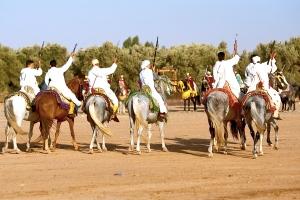
Fantasia, Meknes
FANTASIA – This Festival takes place in May each year
An annual equestrian performance and celebration of traditional folklore in Meknes.
It consists of a group of horse riders, wearing traditional clothes and charging along a straight path at the same speed so as to form a line, at the end of the ride (about a two hundred meters) all riders fire in the sky using old gunpowder guns.The difficulty of the performance is synchronization during the acceleration especially during firing so that one single shot is heard. The two words in Arabic that describe the main events in the Fantasia are ‘harrga’ meaning a movement and ‘barood’ meaning gun-powder. The Fantasia horse and is of type barb. The performance is inspired from historical wartime attacks of Berber and desert knights. Today, Fantasia is considered as a cultural art and a form of martial art.
Each region in Morocco has one or several fantasia groups, called serba, totaling thousands of horse riders nationwide. Performances are usually during local seasonal, cultural or religious festivals, also called mousseum (‘season’ in Arabic).
In most Islamic countries there is an important equestrian tradition based on the meaning of the horse in the Islam. In Saudi Arabia there are Fantasias with “mehari” (riding camels) and in Algeria it is practiced as a collective equestrian game for great traditional celebrations. In this dance, battle rides are stimulated, interspersed with bursts of rifle shots. The dance highlights the nobility of the horseman and the mount. Performed by women from the high mountains of Djurdura, the Kabyle dance celebrates the abundant harvest and olive collecting, where women express their joy prior to Fantasia. The dance is common throughout the west of Algeria and is performed by men. The stamping of the feet which accompanies the dance expresses a bond with the earth and the capacity to endure.
A Fantasia is best characterized as an event with a team of competing horses and complemented by sounds of firing muskets; the latter is mostly done for tourists. Fantasia horses are well bred and well groomed stallions whose bodies are complete muscle. No ordinary work horse is allowed to participate in the Fantasia. Furthermore, there is a Berber saying that “only men and virgin women are allowed to ride these magnificent animals,” because non-virgins may cause the stallion to loose its power and speed.
This colorful display of horsemanship begins with a procession made up of women from the Zayaan tribe on horseback. Traditionally, there is a procession of riders. First in line are the virgin women of the Zayaan tribe; behind them are the village men. Next is the Aid el Baroud (the Festival of Gunpowder). In this section, rows of armed horsemen lined up by rank press their knees forward, dig their heels into the girth, and then take up a fighting position by standing up in their stirrups. The horse riders charge along a straight path at the same speed so as to form a line, at the end of the ride all riders fire in the sky using old a gunpowder gun called a moukahla. The difficulty of the performance is synchronization during the acceleration and especially during firing so that one single shot is heard.
The performance reflects the strong relationship between man and horse as is perceived in Islam. While each region in Morocco has one or several fantasia groups, called serba, if you are a horse aficionado, Tissa will appeal to you the most. Located thirty-three kilometers from Taounate near the Rif Mountains, Tissa is the destination where horses and riders from the region gather to compete in an annual horse fair. The competition is judged on the speed, discipline, and how the horse is outfitted.
You can also experience the Fantasia in Marrakesh, in the evenings outside the city walls near the Bab Jdid in the month of July. There’s also a restaurant called Chez Ali in the palmary of Marrakesh that offers Fantasia, as entertainment, with Berber song, dance and fireworks while you dine over a traditional meal of miswhi (Moroccan roasted lamb) and couscous. Tourists and horse fans across
Morocco can also attend Fantasia in the coastal city of El Jadida, 190 km south of capital Rabat. For the firs time this horse show was held from October 22-26 in 2008 under the theme “Pride and Passion.” The town was transformed into a sight of medieval festivities, color and music.
Fantasia also referred to as the Aiin Aouda, Mock Horse-Back Battle, is an annual equestrian performance and celebration of traditional folklore that takes place in Meknes each July. This horse-riding spectacle includes hundreds of charging horsemen (and women) wearing traditional clothing. Fantasia is a perfect example of traditional folklore in Morocco.
______________________________________________________________________________________________________________________________

Ramadan Laftour, Harira & Dates
RAMADAN – This holy holiday takes place in each year based upon the lunar calendar
An ancient Islamic holiday whereby Muslims fast during daylight hours for thirty days.
Ramadan, considered as the most important holiday in Islam, happens on the ninth month of the twelve month lunar calendar followed in Islam. These lunar months are twelve days shorter than the Gregorian calendar, so Ramadan occurs earlier in each Gregorian year.
During the year of 2008, Ramadan in Morocco, Mauritania and Iran started a day later than in other countries celebrating Ramadan because the crescent of the new moon was not made visible. Muslims are required to wait until they see the moon because the prophet said begin the fast only when you the moon. However, it is usually between the dates of September 1 to September 29 that the ancient rituals of fasting (saum) and praying in accordance with Ramadan are performed.
During Ramadan, a holy holiday, all Muslims fast from sunrise to sunset for one month, only eating after sundown. Non-Muslims are not expected to observe Ramadan, but should be sensitive about not breaking the fast in public. In its observance, Ramadan parallels the traditional Christian Lent. The ninth month of the Islamic calendar, it commemorates the time in which the Koran was revealed to Muhammad. The Ramadan fast involves abstention from food, drink smoking and sex during daylight hours throughout the months. It is forbidden to even drink water. No matter what part of the world you are from, all Muslims follow the same rules and traditions with regards to Ramadan.
During the times when you are allowed to eat, it is important to only eat healthy and nutritious things good for your body. The point of Ramadan is to show devotion to Allah and to become a master in self-discipline.
There are a few groups that are exempt from Ramadan, but are expected to make up the days during a later time. These groups include menstruating and postpartum women, pregnant and breast-feeding women, travelers and anyone who feels sick or weak. In addition, children before puberty do not have to fast, although many do so to practice for half the day.
Other noticeable changes include class hours getting changed so that they do not interfere with daily prayer. Although praying five times a day is the norm in Islam, prayer times are taken more seriously during Ramadan and many Muslims may go to mosque up to several times a day.
Traffic is even crazier than normal during Ramadan. At about five pm, everyone rushes home to eat as soon as the siren goes off. By six pm, the city is silent and streets are bare as most everyone is at home. Around seven pm, Moroccans are back on the street as they head to the mosque for prayer. After prayer, stores and restaurants open.
Most of the local cafes and restaurants close during the day during Ramadan, some closing for the entire month. For this reason, tourists are not recommended to travel to Morocco during this holy month. At sunset signaled by the sounding of a siren and the lighting of lamps in all city minarets an amazing sense of calm takes over the streets as the fast is broken for the day.
Aïd el Fitr (Eid ul-Fitr or Id-Ul-Fitr) marks the end of the thirty day fasting period and is a great celebration throughout the Muslim world. The end of Ramadan is marked by a three day period of special prayers, feasts and sweets.
Traditionally the fast is broken with a bowl of harira and dates. At the breaking of the fast, everyone in the cities and villages spend their evenings celebrating with food and entertainment. The end of Ramadan is celebrated with Aïd es Seghir (Aïd el Fitr, Eid ul-Fitr or Id-Ul-Fitr) a two-day holiday.
While Ramadan may seem like a perplexing holiday to non-Muslims, non-believers may be surprised to learn how much Muslims look forward to the fast. Many feel it is a time of spiritual healing and cleansing. Post Ramadan, many Muslims participate in Shawwal, a six day fast following Aïd el Fitr. Since Ramadan is a holiday of learning to become a better person, Muslims prepare foods and buy presents to give to their friends, family and the poor.
For more information about Morocco Festivals or attending a Festival
For more information about Travel and Tours to Morocco plus highlights on Moroccan culture visit Morocco’s Imperial Cities, Seaside Resorts,Sahara Desert, Berber villages, A Taste of Morocco, Magical Kasbahs, Ruins & Waterfalls, Absolute Morocco, The Best of Marrakech, Fes, and Ouarzazate
 Travel Exploration specializes in Morocco Travel.We provide Tours and travel opportunities to Morocco for the independent traveler and tailor-made tours for families and groups with a distinctly unique flavor. From Morocco’s Seven Imperial Cities, to the Magical Sahara Travel Exploration offers a captivating experience that will inspire you. At Travel Exploration we guarantee that you will discover the best of Morocco! Call Travel Exploration at 1 (800) 787-8806 or 1 (917)703-2078 and let’s book a tour to Morocco for you today.
Travel Exploration specializes in Morocco Travel.We provide Tours and travel opportunities to Morocco for the independent traveler and tailor-made tours for families and groups with a distinctly unique flavor. From Morocco’s Seven Imperial Cities, to the Magical Sahara Travel Exploration offers a captivating experience that will inspire you. At Travel Exploration we guarantee that you will discover the best of Morocco! Call Travel Exploration at 1 (800) 787-8806 or 1 (917)703-2078 and let’s book a tour to Morocco for you today.
Morocco Festivals, Fes Festival of World Sacred Music, Fes Festival, World Sacred Music Festival, World Music Festival Fes, Sacred Music Festival Fes, Gnaoua Festival, Gnawa Festival, El Kellat Des Mgouna Rose Festival, Valley of Roses Festival, Ramadan, Ramadan holy holiday, Fantasia, Fantasia Horse Festival Meknes, Imilchil Marriage Festival, International Film Festival of Marrakech, Marrakesh Film Festival, Timitir Festival, Agadir, Sufi Festival, Suf Festival Fes, Morocco Holidays, Morocco Travel, Travel Exploration, Travel to Morocco
 Travel Exploration specializes in Morocco Travel.We provide Tours and travel opportunities to Morocco for the independent traveler and tailor-made tours for families and groups with a distinctly unique flavor. From Morocco’s Seven Imperial Cities, to the Magical Sahara Travel Exploration offers a captivating experience that will inspire you. At Travel Exploration we guarantee that you will discover the best of Morocco! Call Travel Exploration at 1 (800) 787-8806 or 1 (917)703-2078 and let’s book a tour to Morocco for you today.
Travel Exploration specializes in Morocco Travel.We provide Tours and travel opportunities to Morocco for the independent traveler and tailor-made tours for families and groups with a distinctly unique flavor. From Morocco’s Seven Imperial Cities, to the Magical Sahara Travel Exploration offers a captivating experience that will inspire you. At Travel Exploration we guarantee that you will discover the best of Morocco! Call Travel Exploration at 1 (800) 787-8806 or 1 (917)703-2078 and let’s book a tour to Morocco for you today.






